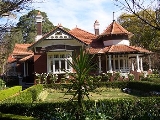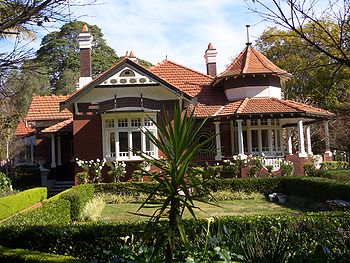
Federation architecture
Encyclopedia

Architectural style
Architectural styles classify architecture in terms of the use of form, techniques, materials, time period, region and other stylistic influences. It overlaps with, and emerges from the study of the evolution and history of architecture...
in Australia
Australia
Australia , officially the Commonwealth of Australia, is a country in the Southern Hemisphere comprising the mainland of the Australian continent, the island of Tasmania, and numerous smaller islands in the Indian and Pacific Oceans. It is the world's sixth-largest country by total area...
, which was prevalent from around 1890 to 1920. The period refers to the Federation of Australia
Federation of Australia
The Federation of Australia was the process by which the six separate British self-governing colonies of New South Wales, Queensland, South Australia, Tasmania, Victoria and Western Australia formed one nation...
on 1 January 1901, when the Australian colonies collectively became the Commonwealth of Australia. It had antecedents in the Queen Anne Style of England and Shingle Style of the Eastern United States.
Definition and features
The Federation period is known within the rest of the CommonwealthCommonwealth
Commonwealth is a traditional English term for a political community founded for the common good. Historically, it has sometimes been synonymous with "republic."More recently it has been used for fraternal associations of some sovereign nations...
as the Edwardian period
Edwardian period
The Edwardian era or Edwardian period in the United Kingdom is the period covering the reign of King Edward VII, 1901 to 1910.The death of Queen Victoria in January 1901 and the succession of her son Edward marked the end of the Victorian era...
, named after the reign of King Edward VII
Edward VII of the United Kingdom
Edward VII was King of the United Kingdom and the British Dominions and Emperor of India from 22 January 1901 until his death in 1910...
(1901–1910). However, as the style preceded and extended beyond Edward's reign, the term 'Federation architecture' was coined in 1969.
Since the Federation of Australia was a significant event during this period, the term 'Edwardian' is seldom used in Australia. Federation architecture has many similarities to Edwardian architecture
Edwardian Baroque architecture
The term Edwardian Baroque refers to the Neo-Baroque architectural style of many public buildings built in the British Empire during the Edwardian era ....
. There are significant differences, however which distinguished the style in Australia, particularly due to the embracing of Australiana
Australiana
Australiana is an item of historical or cultural interest of Australian origins. Australiana often borrows from Australian Aboriginal culture, or the stereotypical Australian culture of the early 1900s....
themes and the use of the verandah
Verandah
A veranda or verandah is a roofed opened gallery or porch. It is also described as an open pillared gallery, generally roofed, built around a central structure...
in domestic settings. Australian flora and fauna featured prominently, and stylised images of the New South Wales waratah
Telopea speciosissima
Telopea speciosissima, commonly known as the New South Wales waratah or simply waratah, is a large shrub in the plant family Proteaceae. It is endemic to New South Wales in Australia and is the floral emblem of that state...
, flannel flower
Actinotus helianthi
Actinotus helianthi known as the Flannel Flower, is a common sight in bushland around Sydney, Australia.Despite its appearance, it is not a member of the daisy family but rather a species of flowering plant of the Apiaceae family, the same family as the carrot...
, Queensland firewheel tree
Stenocarpus sinuatus
Stenocarpus sinuatus, known as the Firewheel Tree is an Australian rainforest tree in the Protea family. The range of natural distribution is in various rainforest types from the Nambucca River in New South Wales to the Atherton Tableland in tropical Queensland...
and other flowers, and Kangaroo, kookaburra
Laughing Kookaburra
The Laughing Kookaburra, Dacelo novaeguineae, is a carnivorous bird in the kingfisher family Halcyonidae. Native to eastern Australia, it has also been introduced to parts of New Zealand, Tasmania and Western Australia. Male and female adults are similar in plumage, which is predominantly brown and...
, lyrebird
Superb Lyrebird
The Superb Lyrebird is a pheasant-sized songbird, approximately 100cm long, with brown upper body plumage, grayish-brown below, rounded wings and strong legs...
, were common. The Coat of Arms, and rising sun, representing a new dawn in the country of Australia, also appeared regularly on gables.
Many Federation buildings, both residential and non-residential, are listed on the Register of the National Estate
Register of the National Estate
The Register of the National Estate is a listing of natural and cultural heritage places in Australia. The listing was initially compiled between 1976 and 2003 by the Australian Heritage Commission. The register is now maintained by the Australian Heritage Council...
because of their heritage values.
Gardens and garden architecture
Gardens of the period were complex and contained many elements - generally a wider variety of plants than is seen in contemporary plantings, pergolas, rose arches, gazebos and summerhouses. Wooden lattice fences were used to partition parts of the garden off, particularly the front from the more private back. Garden paths could be straight or gently curved, and often edged with glazed edging tiles or bricks, and made of tiles, packed gravel or bricks. patterns for brick paving include stretcher bond, herringbone and basketweave. Asphalt and concrete were not used.Plants were selected to produce year-round colour and interest in the local climate conditions. Initially, evergreen trees were used, but the denseness of shade led to increasing popularity of deciduous trees such as jacaranda, flowering plum and peppercorn. Palms often framed the garden vista, and the native Cootamundra wattle was popular, as were shrubs such as Camellias and standard roses. Conservatories contained begonias and adiantum ferns.
Styles
There are twelve Federation styles:- Federation Academic Classical
- Federation Free Classical
- Federation Filigree
- Federation Anglo-Dutch
- Federation Romanesque
- Federation Gothic
- Federation Carpenter Gothic
- Federation Warehouse
- Federation Queen Anne
- Federation Free Style
- Federation Arts and Crafts
- Federation Bungalow
Residential architecture
Of the twelve Federation styles, there are four that were mainly used in residential architecture. They are Federation Queen Anne style; Federation Filigree style; Federation Arts and Craft style; and Federation Bungalow style.Federation Queen Anne
The Federation Queen Anne style was designed to embrace the outdoor lifestyles of the Australian people. Most homes have front verandas with decorative timber features, tiling on the patio floor and entry paths. The brickwork is usually a deep red or dark brown, often with a mix of the two. The roofs are typically terracotta tiles with decorative gables, motifs, timber features, tall chimneys and fretworkFretwork
Fretwork is an interlaced decorative design that is either carved in low relief on a solid background, or cut out with a fretsaw, coping saw, jigsaw or scroll saw. Most fretwork patterns are geometric in design. The materials most commonly used are wood and metal. Fretwork is used to adorn...
. Decorative leadlight windows are also common, as are circular windows (known as bulls-eye windows). Federation homes also have decorative internal features in the plasterwork, high ceilings and timber features.
Some outstanding examples are West Maling, Penshurst Avenue, Penshurst, New South Wales; Ingleholme, Boomerang Street, Turramurra, New South Wales (former home of architect John Sulman
John Sulman
Sir John Sulman was an Australian architect. Born in Greenwich, England, he emigrated to Sydney, Australia in 1885. From 1921 to 1924 he was chairman of the Federal Capital Advisory Committee and influenced the development of Canberra.-Early life:Sulman was born in was born at Greenwich, England...
and designed by him); and Caerleon, Ginahgullah Road, Bellevue Hill, New South Wales. The Federation Queen Anne style was the most popular residential style in Australia between 1890 and 1910.
Federation Filigree
The Federation Filigree style is common in the hotter parts of Australia, especially in the north, since it is designed to create shade while allowing for the free flow of air. It is a common sight in Queensland and is sometimes known as the Queensland style. Some outstanding examples are Belltrees House, Scone, New South Wales; private home, Roderick Street, Ipswich, Queensland; and terrace of homes, east side of High Street, Millers Point, New South Wales.Federation Arts and Craft
The Federation Arts and Craft style had its origins in England, where architects were reacting to the impersonal nature of the Industrial Revolution. Crafts and handiwork were emphasised to give architecture the "human touch". These influences were absorbed into Federation Australia, where the resulting buildings were generally small-scale to medium-scale and predominantly residential. Outstanding examples are Glyn, Kooyong road, Toorak, Victoria; The Crossways, Martin Road, Centennial Park, New South Wales; and Erica, Appian Way, Burwood, New South Wales.Federation Bungalow
The Federation Bungalow style was the Australian response to the bungalow style that was developed in America by people like Gustav Stickley. It can be seen as a transition phase between the Federation Queen Anne style and the California Bungalow style that took on later. Stylistically, it exploited the qualities of the bungalow while frequently retaining the flair and idiosyncrisies of the Queen Anne style, although usually in simplified form. Outstanding examples are Nee Morna, Nepean Highway, Sorrento, Victoria; Blythewood, Beecroft Road, Cheltenham New South Wales; and The Eyrie, Fox Valley Road, Wahroonga, New South Wales.Non-Residential Architecture
Federation non-residential buildings can be in any of the twelve styles. The following gallery shows some examples of non-residential buildings.See also
- Australian architectural stylesAustralian architectural stylesAustralian architectural styles, like the revivalist trends which dominated Europe for centuries, have been primarily derivative.-Background:...
- Australian residential architectural stylesAustralian residential architectural stylesAustralian residential architectural Periods can be broadly categorised as follows :*Pre-Colonial Period 30,000 BCE - 1788 CE*Old Colonial Period 1788 - c. 1840*Victorian Period c. 1840 - c. 1890...
- Australian non-residential architectural stylesAustralian non-residential architectural stylesAustralian non-residential architectural styles are a set of Australian architectural styles that apply to buildings used for purposes other than residence and have been around only since the first colonial government buildings of early European settlement of Australia in 1788.Their distribution...
- Gallery of Federation Architecture
- Gallery of Sydney Architecture
- Appian Way, Burwood, SydneyAppian Way, Burwood, SydneyAppian Way is a street located in the suburb of Burwood in Sydney, New South Wales, Australia.The state heritage listed Appian Way has been described as one of the finest streets of Federation houses in Australia. The picturesque houses create an asymmetrical, multi-gabled roofscape with a variety...

